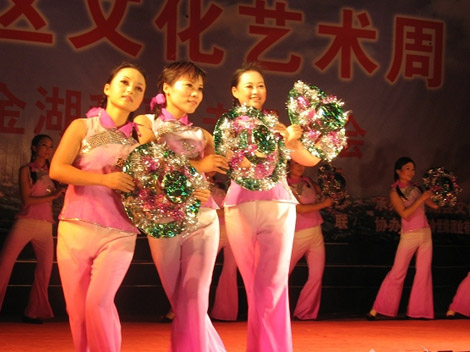
Located in the Basin of Lixiahe River in North Jiangsu Province, Jinhu County is surrounded by a lake on three sides. With a vast water area, the county abounds in rice, fish and shrimps. Jinhu County is thus acknowledged as "Land of Fish and Rice". Jinhu Yangko is a unique form of singing which has been created by laboring people in Jinhu area during their long-term rice transplantation. It is fruit of their plain emotions and collective wisdom. Integrating lyrics, melodies as well as accompaniment of gongs and drums, Jinhu Yangko can be divided into two categories, namely, the professional and amateur.
Professional singers of Jinhu Yangko are called "Luogu Shifu", literally meaning masters of gongs and drums. Jinhu Yangko is usually performed in couples. One beats the drum while the other strikes the gong, serving as transition or accompaniment. The one playing a drum is the leading singer, accompanied by the other playing a gong. Occasionally, they alternate their roles. The amateur performance is evolved from gong-drum yangko. First, one of the couple will chant "gedongzai" as replacement for accompaniment of gongs and drums. This is called "Dagu Haozi", meaning a drumbeat-like chant. The other will be the leading singer. The drumbeats in the middle will also be accompanied by the first person with complementary syllables. The tune of Jinhu Yangko is represented by amateur singing. Major tunes include "Sijutou" (every line comprises seven syllables, and every stanza comprises four lines), "Wujuban" (based on "Sijutou", half a complementary line and a concluding line are added), "Qiangbaju" (a four-line allegretto-like spoken part is added to "Sijutou") and "Chuanshizi" (every line comprises ten syllables, and every stanza comprises two lines). Under the influence of Canal Culture, most of the numerous pornographic poems and narratives in Jinhu Yangko derived from Yangzhou brothel ditties in the Ming and Qing Dynasties. As time passes, Jinhu Yangko has been interacting with other art forms such as exotic folk songs, plays and Baojuan (a theatric performance of talking and singing). During this process, Jinhu Yangko has been gradually modified. Years of blending and sedimentation has given rise to the unique tune and style of Jinhu Yangko.





